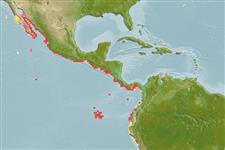Environment: milieu / climate zone / depth range / distribution range
Οικολογία
Θαλασσινό(ά) Υφαλόφιλο(α); εύρος βάθους 0 - 18 m (Ref. 5227). Tropical; 30°N - 10°S, 120°W - 70°W
Eastern Pacific: Bahía Sebastían Vizcaino and the northern Gulf of California (Isla Angel de la Guarda and Puerto Lobos) to Peru, including the Galapagos Islands (Ref. 5590).
Μέγεθος / Βάρος / Age
Maturity: Lm ? range ? - ? cm
Max length : 18.0 cm SL αρσενικό/απροσδιόριστο; (Ref. 28023); common length : 12.0 cm TL αρσενικό/απροσδιόριστο; (Ref. 55763)
Short description
Μορφολογία | Μορφομετρία
Body cylindrical; head with cirri above the eyes, on the nape, and at the posterior edge of the anterior nostril; maxillary not protrusible; each jaw with one row of incisiform teeth; anal and dorsal fins elongated ; lateral line divided into two, independent, overlapping segments (Ref. 55763).
Adults prefer the surge zone of unprotected rocky headlands with steep slopes. They wedge themselves in crevices close to shore in shallow water, darting out to defend their territory. Diurnal feeders that graze on algae and sessile invertebrates, using their comb-like incisor teeth to scrape food (Ref. 28023). Oviparous. Eggs are demersal and adhesive (Ref. 205), and are attached to the substrate via a filamentous, adhesive pad or pedestal (Ref. 94114). Larvae are planktonic, often found in shallow, coastal waters (Ref. 94114).
Life cycle and mating behavior
Γεννητική Ωρίμανση | Αναπαραγωγή | Γεννοβολία | Αβγά | Γονιμότητα | Προνύμφες
Oviparous, distinct pairing (Ref. 205).
Thomson, D.A., 1987. Reef fishes of the Sea of Cortez. The rocky-shore fishes of the Gulf of California. The University of Arizona Press, Tucson. 302 p. (Ref. 5592)
IUCN Red List Status (Ref. 130435)
Threat to humans
Harmless
Human uses
αλιεία: χωρίς ενδιαφέρον; Ενυδρείο: Εμπορικό(ά)
Περισσότερες πληροφορίες
ΑναφορέςΥδατοκαλλιέργειεςΠροφίλ υδατοκαλλιέργειαςΣτελέχοιΓενετικήElectrophoresesΚληρονομικότηταΑσθένειεςΜεταποίησηNutrientsMass conversion
ΣυνεργάτεςΦωτογραφίεςStamps, Coins Misc.ΉχοιΣιγκουατέραΤαχύτηταΚολυμβητικός ΤύποςΕπιφάνεια βραγχίωνOtolithsΕγκέφαλοιΌραση
Εργαλεία
Special reports
Download XML
Διαδικτυακές πηγές
Estimates based on models
Preferred temperature (Ref.
123201): 20.3 - 29.1, mean 26.1 °C (based on 200 cells).
Phylogenetic diversity index (Ref.
82804): PD
50 = 0.5312 [Uniqueness, from 0.5 = low to 2.0 = high].
Bayesian length-weight: a=0.00955 (0.00505 - 0.01805), b=2.99 (2.83 - 3.15), in cm total length, based on LWR estimates for this species & (Sub)family-body (Ref.
93245).
Τροφικό Επίπεδο (Ref.
69278): 2.7 ±0.25 se; based on food items.
Ελαστικότητα (Ref.
120179): Μεσαίο(α), ελάχιστος χρόνος για διπλασιασμό πληθυσμού 1,4 - 4,4 έτη (Assuming tm=1 and Fec 100-1000).
Fishing Vulnerability (Ref.
59153): Low vulnerability (12 of 100).
Nutrients (Ref.
124155): Calcium = 82.9 [47.2, 125.0] mg/100g; Iron = 0.688 [0.441, 1.054] mg/100g; Protein = 18.7 [17.6, 19.6] %; Omega3 = 0.129 [0.087, 0.193] g/100g; Selenium = 22.1 [13.5, 38.2] μg/100g; VitaminA = 120 [41, 341] μg/100g; Zinc = 1.82 [1.31, 2.45] mg/100g (wet weight);
